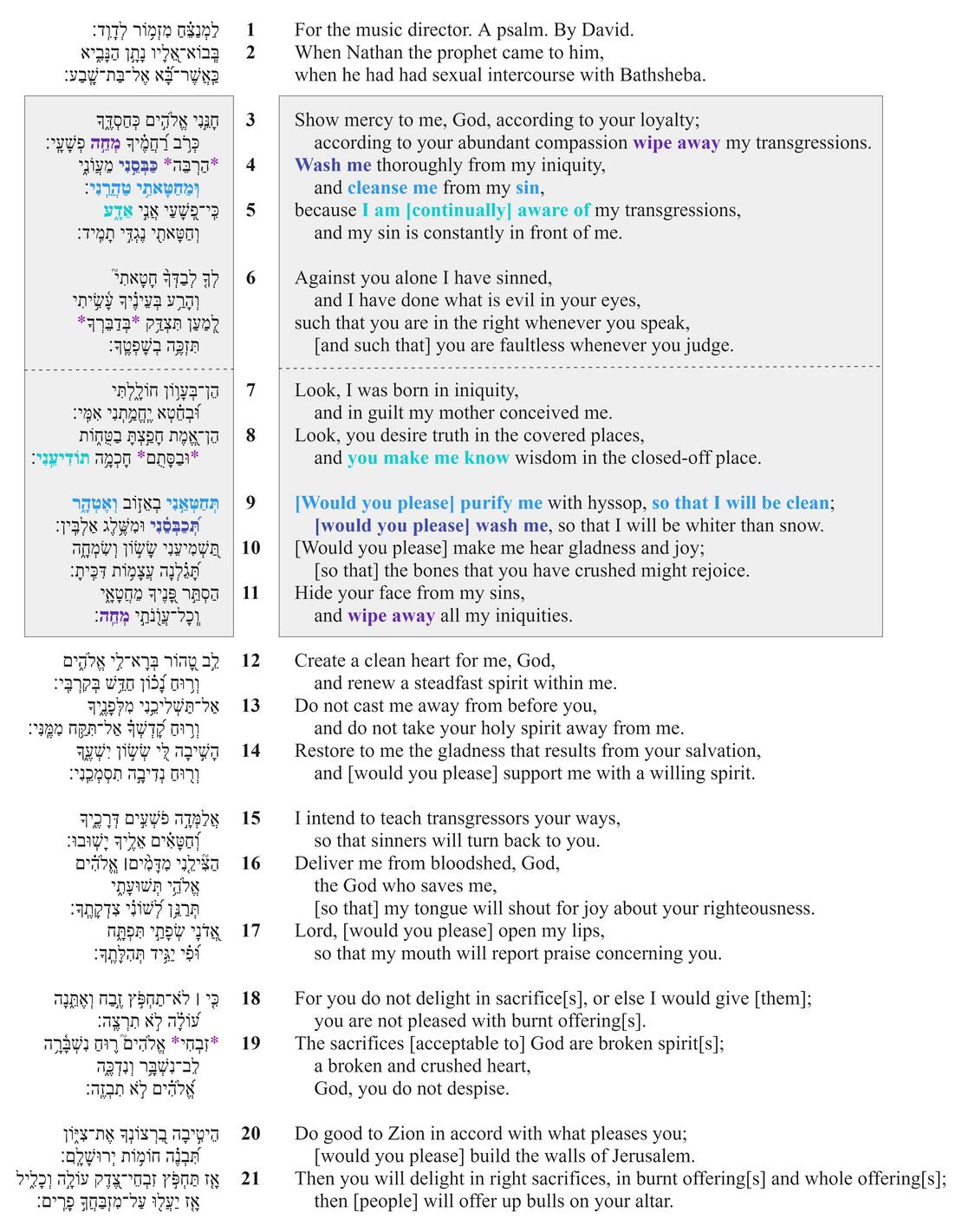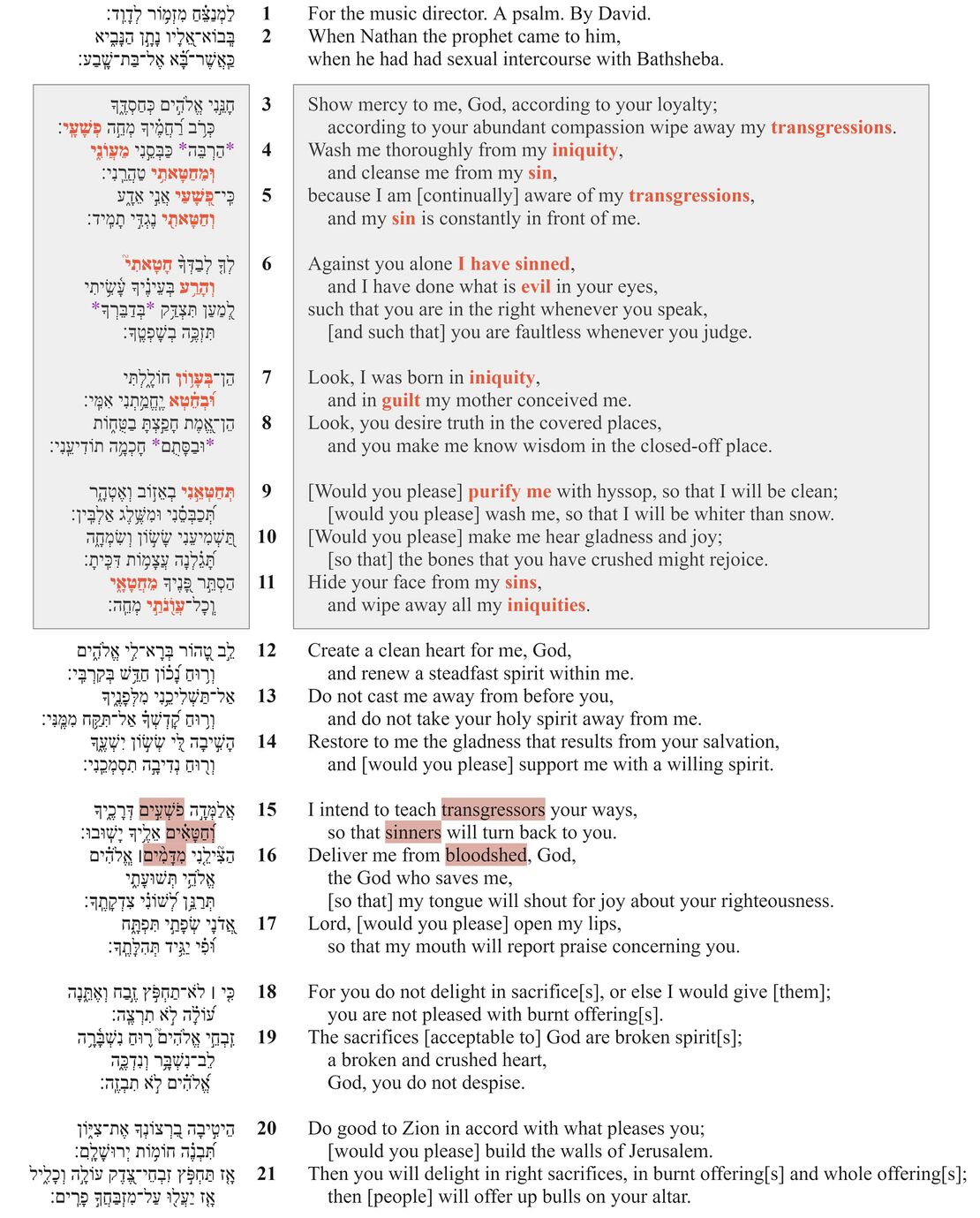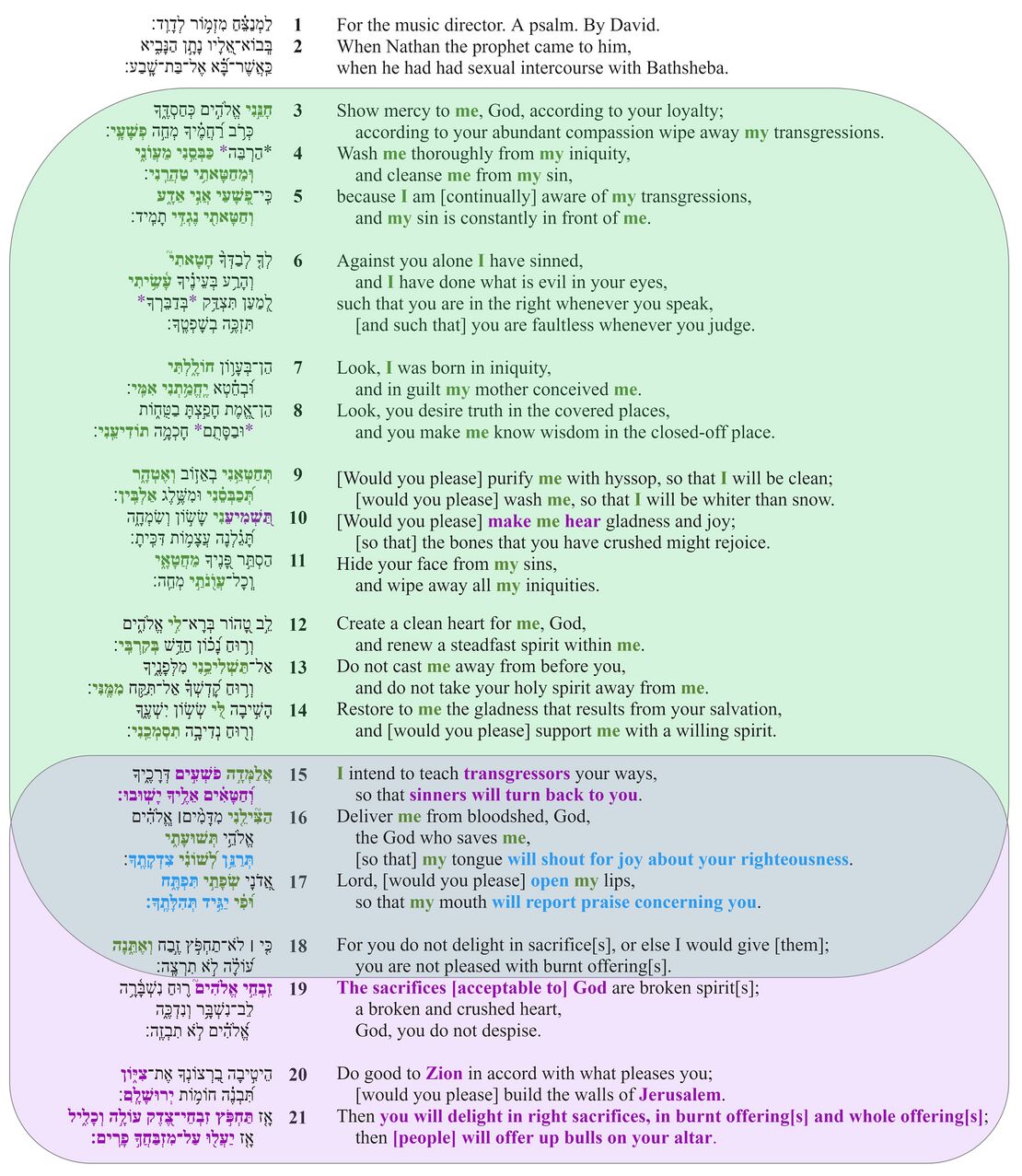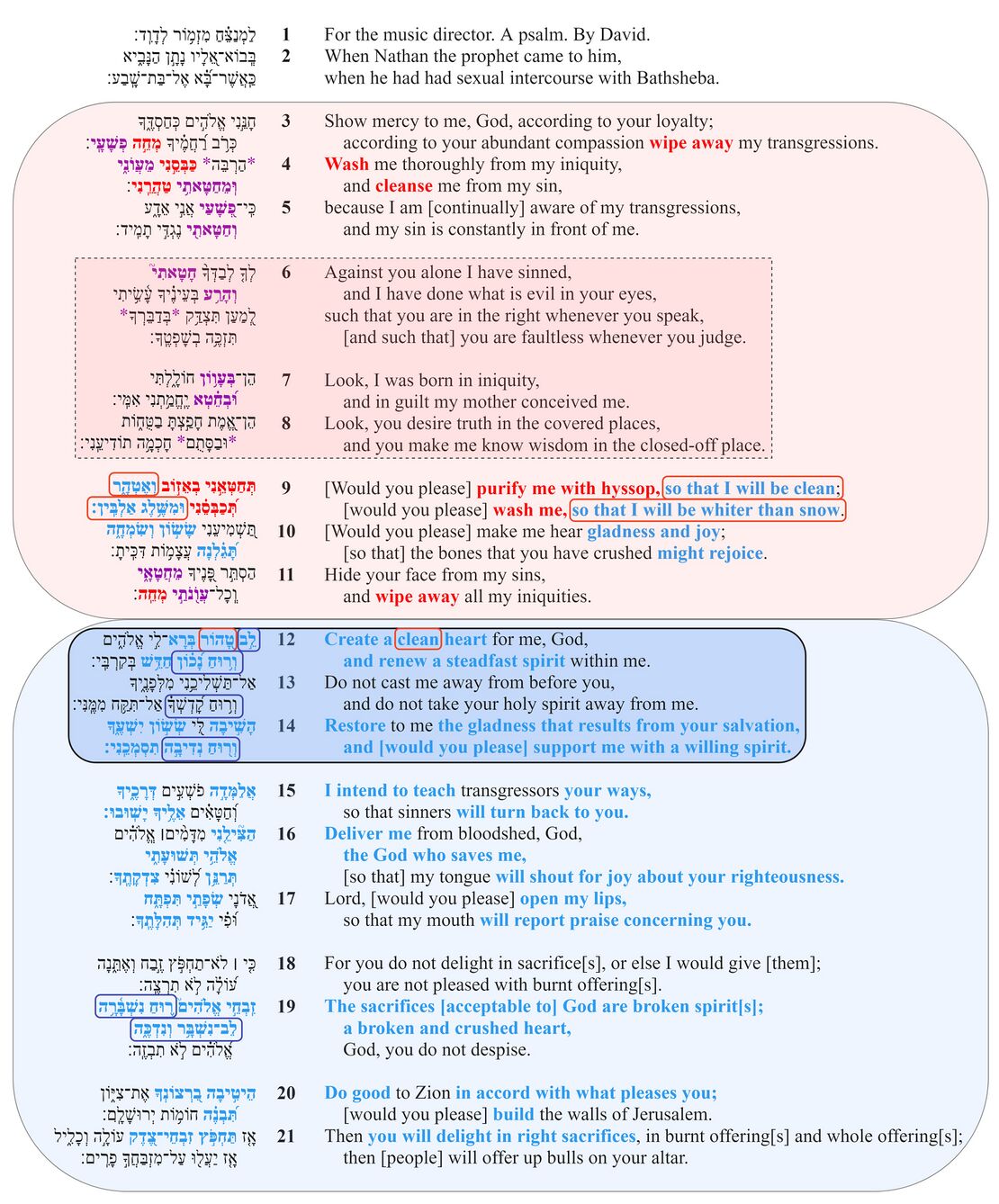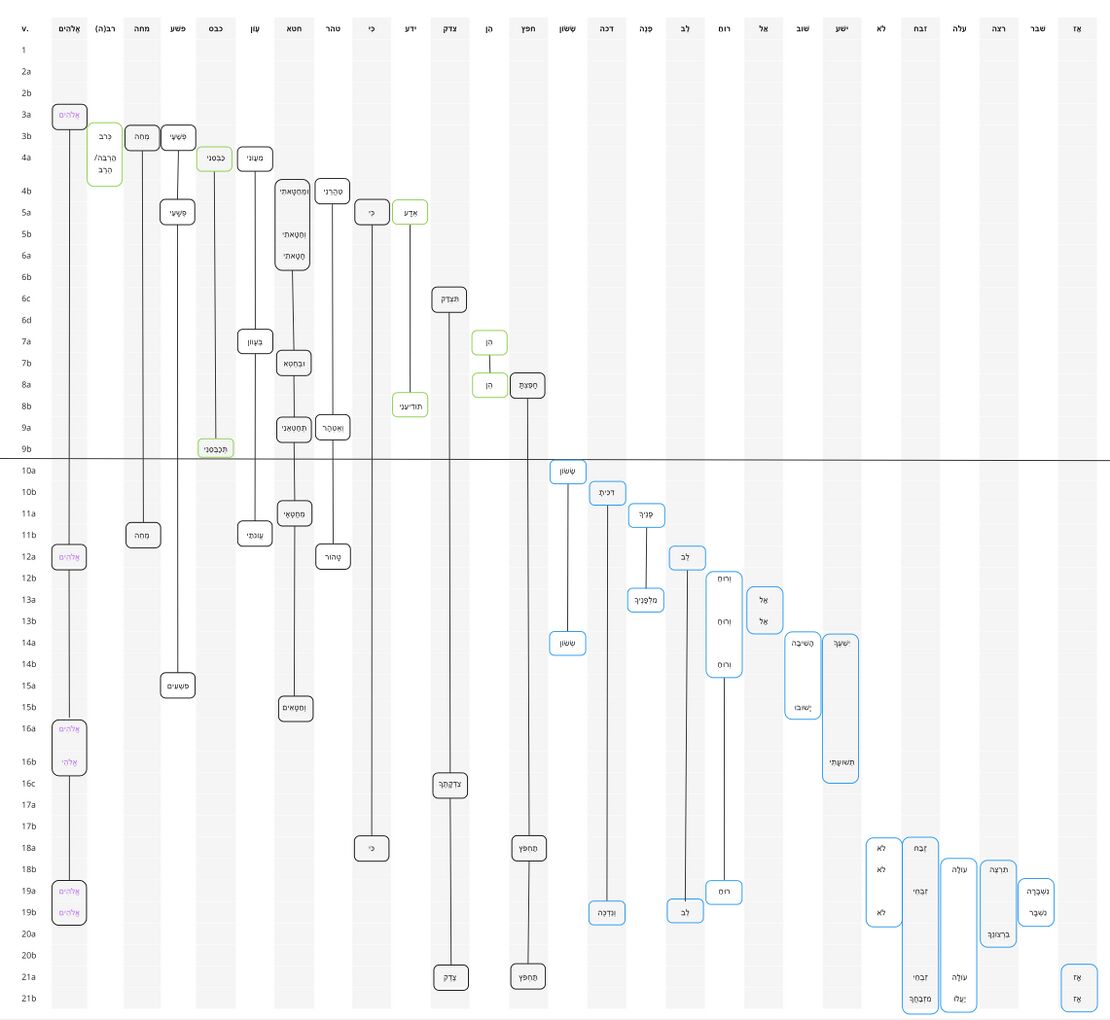Psalm 51 Poetic Features
Poetic Features
In poetic features, we identify and describe the “Top 3 Poetic Features” for each Psalm. Poetic features might include intricate patterns (e.g., chiasms), long range correspondences across the psalm, evocative uses of imagery, sound-plays, allusions to other parts of the Bible, and various other features or combinations of features. For each poetic feature, we describe both the formal aspects of the feature and the poetic effect of the feature. We assume that there is no one-to-one correspondence between a feature’s formal aspects and its effect, and that similar forms might have very different effects depending on their contexts. The effect of a poetic feature is best determined (subjectively) by a thoughtful examination of the feature against the background of the psalm’s overall message and purpose.
Complete Confession
If an emendation or revocalization is preferred, that emendation or revocalization will be marked in the Hebrew text of all the visuals.
| Emendations/Revocalizations legend | |
|---|---|
| *Emended text* | Emended text, text in which the consonants differ from the consonants of the Masoretic text, is indicated by blue asterisks on either side of the emendation. |
| *Revocalized text* | Revocalized text, text in which only the vowels differ from the vowels of the Masoretic text, is indicated by purple asterisks on either side of the revocalization. |
Feature
The first half of the psalm (vv. 3-11) is bound together by a chiasm with the inverted repetition of the key words מחה, כבס, חטא+טהר, and ידע. Furthermore, the key words given in the A lines in vv. 3-6 are repeated in the B lines in vv. 7-11.
The central part of this section is less obviously chiastic, since the keyword repetition does not continue as distinctly in the central section of vv. 6-7. Nevertheless, vv. 5b, 6a, and 7b use the root חטא, and v. 6b uses the word עין "eye" which is graphically/orally similar to the word עון "iniquity" in 7a. Sometimes v. 6 (or part thereof, especially 6c-d, which is the center of vv. 6-7) is identified as the center of the chiasm. Quantitatively, however, there is no central verse. Instead, the chiasm is divided into two equal parts with five bicola each.
The central vv. 6-7 are relatively prominent in the first half. Not only are they focused in the chiasm, but they also are among the most emotionally charged and hyperbolic verses in the entire psalm.
Effect
The primary effects of this chiasm are to tie vv. 3-11 closely together as a coherent poetic unit and to highlight the central emotional peak of the psalm in vv. 6-8. This unit is characterized by corresponding pleas for cleansing at the beginning and end of the section, with a central confession providing the grounds for the pleas.
- Plea (vv. 3-5)
- Confession (v. 6)
- Confession (vv. 7-8)
- Plea (vv. 9-11)
The chiasm gives the impression of a complete plea for cleansing that is well-grounded in honest confession (see especially v. 8). It is as if the psalmist has iconically presented the perfection of his confession and plea by encapsulating it in a complete structural form. He has done everything he can to confess his sins and ask God for cleansing, and now it is in God's hands whether and how to answer.
The psalmist begins with a desperate plea (vv. 3-5). Then he moves into the central (and structurally prominent) part of the chiasm (vv. 6-7), which consists of a vivid confession that admits the sin (v. 6a-b), recognizes the righteousness of God's judgment (v. 6c-d), and expresses in hyperbolic terms the overwhelming pervasiveness of the sin (vv. 5, 7). Because of the emotional and hyperbolic language, as well as the mirative particle הן, vv. 6-8 can be understand as the emotional peak of the psalm, in contrast to the main discourse/thematic peak in vv. 12-14. The concluding plea (vv. 9-11) repeats the elements of the initial plea in reverse order, bringing the whole section to a close, suggesting denouement and resolution on the part of the psalmist. Vv. 9-10 also begin to emphasize positive states envisioned for the future in anticipation of later developments in the psalm. Thus, vv. 9-11 reflect a lowering level of emotional intensity before the major turning point in v. 12.
Iconic Removal of Sin
If an emendation or revocalization is preferred, that emendation or revocalization will be marked in the Hebrew text of all the visuals.
| Emendations/Revocalizations legend | |
|---|---|
| *Emended text* | Emended text, text in which the consonants differ from the consonants of the Masoretic text, is indicated by blue asterisks on either side of the emendation. |
| *Revocalized text* | Revocalized text, text in which only the vowels differ from the vowels of the Masoretic text, is indicated by purple asterisks on either side of the revocalization. |
Feature
The first part of the psalm (vv. 3-11) is replete with lexical repetitions of words for wrongdoing, including פשע, עון, חטא(ה), and רע. On the other hand, none of these roots occur in the second half of the psalm (vv. 12-21) except in vv. 15-16 (including דָּמִים in v. 16, for which see Verse-by-Verse notes), where they refer not to the psalmist, but other sinners who will need cleansing in the hypothetical future.
Effect
The effect of this poetic feature is to iconically represent the removal of the psalmist's sin. In the first half of the psalm (vv. 3-11), the psalmist is overwhelmed by the pervasiveness of his sin. But in the second half of the psalm (vv. 12-21) he never mentions his personal sin again. It is as if the psalmist's plea for cleansing has been effective. The psalmist overcomes his overwhelming feelings of guilt and begins to anticipate a more hopeful future as a pure worshipper.
From Contrition to Community
If an emendation or revocalization is preferred, that emendation or revocalization will be marked in the Hebrew text of all the visuals.
| Emendations/Revocalizations legend | |
|---|---|
| *Emended text* | Emended text, text in which the consonants differ from the consonants of the Masoretic text, is indicated by blue asterisks on either side of the emendation. |
| *Revocalized text* | Revocalized text, text in which only the vowels differ from the vowels of the Masoretic text, is indicated by purple asterisks on either side of the revocalization. |
Feature
The entirety of Psalm 51 is in the form of a personal lament in the mouth of an individual "I." Explicit first person self-references occur throughout the psalm up through v. 18, but there is no need to see a change of speaker anywhere in vv. 19-21. Nevertheless, starting in v. 15 and continuing to the end of the psalm, there is a marked emphasis on corporate worship. V. 15 announces the psalmist's intention to instruct a plurality of others (= "sinners") in repentance and right worship, who presumably become the restored community of Zion who offer pleasing sacrifices to God in vv. 19-21. Furthermore, vv. 16-17 express the psalmist's own desire to be able to praise the Lord audibly, presumably also in the context of a gathering for corporate worship. The context of joyful corporate worship may already be anticipated by the reference to "hearing" gladness and joy in v. 10, which seems to imply the presence of joyful others. With the possible exception of v. 10, the individual and corporate words overlap only in vv. 15-18.
Effect
The effect of this poetic feature is to bring out the corporate ramifications for the restoration of the individual requested in vv. 12-14. The distribution of first person and plural references iconically represents the transition from the concerns of the individual to those of the community, as the individual instructs the community and then gradually fades into the background of communal worship that is pleasing to God.
Up until v. 15, the psalmist is entirely inwardly self-focused, dwelling on his internal wrestling with sin and desire for personal spiritual transformation. But v. 15 signals a shift towards a new, outward-looking orientation, where the psalmist is interested in praising God and leading others to repentance and right worship. Vv. 15-17 introduce this shift by expressing the psalmist's desire to praise God and instruct sinners. Vv. 18-19 establish the right posture for pleasing spiritual worship, which the psalmist hopes to exemplify and teach to the sinners mentioned in v. 15. And vv. 20-21 conclude the psalm with a plea for collective restoration so that others will put into practice the lessons learned and offer right sacrifices that are pleasing to God.
The right (communal) worship referred to in vv. 15-21 is presented as a powerful motivation for God to act on behalf of the psalmist, but also reflects the psalmist's developing thought and shifting focus from the self towards others, especially God himself who deserves the worship and praise. If the psalmist is functioning as a leader of the people, then corporate restoration may even have been a major motivating principle from the start, rather than an afterthought.
From Cleansing Sin to Restoring the Spirit
Feature
The first half of the psalm (vv. 3-11) is thematically dominated by pleas for cleansing from sin, picturing sin and guilt as something negative that needs to be removed. The center of this section is an emotionally charged and hyperbolic confession and lament about the overwhelming pervasiveness of the psalmist's sin and the righteousness of God's judgment that heightens the need for cleansing (vv. 6-8).
The psalm pivots at v. 12, which is at the center of the psalm both positionally and rhetorically (so also Fokkelman 2000, 165; Labuschagne 2008, observation 1; Van der Lugt 2010, 96). V. 12 is at or near the midpoint of the psalm and is the start of the second major structural division of the psalm (vv. 12-17) and the transition point where sin is iconically removed. V. 12 begins with fronted focal elements in both the A and B lines. Finally, the threefold fronted repetition of רוח in the B lines of vv. 12-14 indicates a marked prominence for these verses, which could be considered the thematic peak of the discourse with v. 12 as the key pivot point.
V. 12 prompts a shift from a focus on cleansing of sin to a focus on creating new and positive states and events throughout the second half of the psalm (vv. 12-21). V. 12 restates the psalmist's desire for purity, but does so by positively reframing the plea as a request for God to create a new heart and spirit (both boxed in blue) for him. Vv. 13-14 further stress the need for "spirit" by emphasizing God's holy spirit and the psalmist's willing spirit as necessary for the desired restoration. The rest of vv. 12-21 are dominated by positive references to anticipated good states, emotions, and actions. This is anticipated already by two features. First, v. 9 anticipates purity as a future positive state resulting from cleansing, even though purity remains within the semantic domain of cleansing (boxed in red). Second, the request for joy in v. 10, together with a corresponding request for joy in v. 14 that envelops vv. 11-13, serves to further put the focus on v. 12 as the major pivot point.
Effect
The effect of this poetic feature is to highlight a major reorientation in the psalmist as the psalm progresses. This reorientation is emphatically marked by the discourse peak of vv. 12-14, which is the turning point in the whole psalm and introduces the crucial theme of the restored heart and spirit that is so essential for both personal and collective restoration.
At first the psalmist is totally consumed with dealing with his sin and having it removed. With that sufficiently addressed, the psalmist is prepared to look ahead hopefully to a more positive future where God creates something new and good. The first half is essentially subtractive and negative in orientation, while the second half is additive and positive. In the first half, the psalmist is largely a passive patient in the act of expiation, whereas in the second half the psalmist takes on a more active role as co-agent with God as part of a process of restoration and spiritual transformation into a right worshipper. All of this is accomplished through the repeated theme of the spirit, whereby the psalmist's spirit is made steadfast and willing by God's empowering holy spirit and is, therefore, made into the type of spirit that is acceptable to God (v. 19).
Repeated Roots
The repeated roots table is intended to identify the roots which are repeated in the psalm.
| Repeated Roots legend | |
|---|---|
| Divine name | The divine name is indicated by bold purple text. |
| Roots bounding a section | Roots bounding a section, appearing in the first and last verse of a section, are indicated by bold red text. |
| Roots occurring primarily in the first section are indicated in a yellow box. | |
| Roots occurring primarily in the third section are indicated in a blue box. | |
| Roots connected across sections are indicated by a vertical gray line connecting the roots. | |
| Section boundaries are indicated by a horizontal black line across the chart. | |


